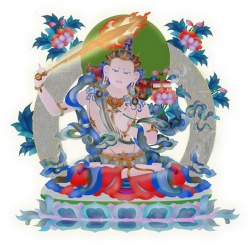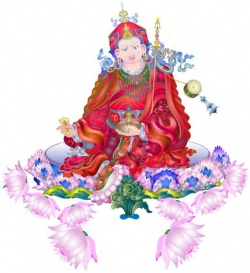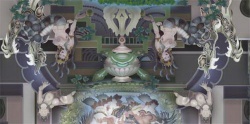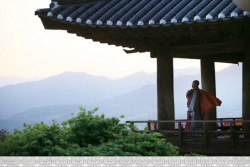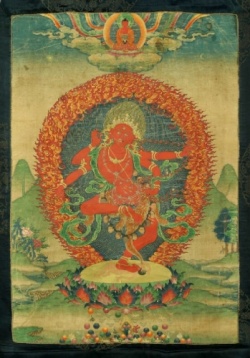The Power of Faith & Devotion: Votive Images and Talismans in Buddhist Art
The Power of Faith & Devotion:
Votive Images and Talismans in Buddhist Art Buddhist art came into gradual existence approximately 500 years after the death of the historical Sakyamuni Buddha. The early Buddhist artworks did not take the forms of Buddha himself but took the form of subject matters which were related to Buddha (eg the Footprint which signifies the Buddha; the Bodhi Tree which signifies the enlightenment of Sakyamuni Buddha under such Tree; the Dharmachakra Wheel which signifies the teachings of the Buddha; and the Deer which signifies Buddha’s First Sermon in the Deer Park in Benares, India). Votive images are basically visual expressions of faith and devotion in Buddhist iconography. They are usually made out of moulds. The main material used for making votive images is basically clay. They are also made from bronze and other metal alloys. However, gold and silver are also used to make votive images but they are rare to come by. Votive images are indeed great works of art but being smaller in size resulted in many museums not emphasising or highlighting them in their display. The significance of votive images is not fully understood by many but they actually play a very important role in everyday Buddhists’ practices, customs and beliefs. Votive images are often used as “reminders” of the Buddha and his Teachings. By looking at them, one could easily be inspired with faith and devotion as the Sakyamuni Buddha himself had overcome hatred, ignorance and greed to be the Enlightened One. Also, one can be overwhelmed with a sense of gladness, happiness, serenity and peace of mind when one sees and appreciates such votive images. In this respect, the Indian scholar Matrceta
once said the following words most aptly:
“Your Form is a jewel to see,
your speech is a jewel to hear,
your teaching are a jewel to reflect upon. Truly, you are a mine bearing the jewels of goodness. Just to hear you brings joy:
just to look upon you calms the heart;
your speech refreshes and your teaching frees.” 2
It is to be noted that the making of votive images is encouraged in many major Sutras because it is regarded as act of making, gaining and accumulating merits. As a result, many votive images of diverse styles, forms and materials were made from different Buddhist traditions and countries over a long period of time. Thus, in the Lotus Sutra
,
the following words of guidance were taught in respect of the making of Buddha images: “
If men for the sake of buddhas / Have erected images / Carved with the characteristic signs, / [They} have all attained the Buddha-way. / Or those who with the precious seven, / With brass, red and white copper, / With wax, lead, and tin, / With iron, wood, and clay, / Or with glue and lacquer/ Have adorned and made buddhas’ images, / All such ones as these / Have attained the Buddha-way. / Those who have painted buddhas’ images / With the hundred blessing-adorned signs, / Whether done by themselves or by employing others, / Have attained the Buddhaway. / Even boys in their play / Who with reed, wood, or pen / Or with the fingernail / Have drawn buddhas’ images, / All such ones as these, / Gradually accumulating merit / And perfecting hearts of great pity, / Have attained the Buddha-way;
”
Further, in the Sutra On The Original Vows And The Attainment Of Merits Of Ksitigarbha Bodhisattva, the following words of wisdom were taught in the same respect: “
If parents or relatives of the dying person sell all of his belongings, riches, properties, and use the money to make images of Ksitigarbha Bodhisattva, then the dying person comes to know the meritorious deeds on his behalf, although the person should suffer a severe disease according to his own Karma, but instead he fully recovers very soon and has longevity.
If sentient beings of the present or the future who have lost their parents, sisters or brothers during their early childhood and think of their deceased relatives when they are fully grown up and long to know where they have been reborn, such grown up person can make images of Ksitigarbha Bodhisattva, hearing then his name, admiring his image or paying homage to him from one day to seven days continuously without any retreat although the deceased relatives may merit being cast into the evil realms for kalpas, but due to the meritorious deeds practised on their behalf, they are free from their punishment and will be reborn either as devas or human receiving great bliss.” In the Buddha’s answers to Sumati’s Questions
, the Buddha explained to Sumati with
the following words to resolve her doubts: 3
“Sumati, if a Bodhisattva achieves four things, he will be endowed with a graceful appearance. What are the four?
(1) Not to be angry [even] with a bad friend; (2) to have great kindness;
(3) to rejoice in the true Dharma; and
(4) to make images of Buddhas.”
Quite apart from the fact that votive images were made for merit purposes and as “reminders” of the Buddha and his Teachings, they are gradually and subsequently used and worn as talismans particularly the smaller votive images. Many Buddhists wear them as talismans to ward off dangers and evils and to give them protection and well-being. This is quite understandable as votive images are receptacles or depositories of positive and superlative power and energy. The source of such positive and superlative power and energy emanates or derives from, inter-alia, the following: (a) the “presence” of the Buddha himself physically on the votive images often with fiery and radiating halo or aureole or in His metaphysical or spiritual aspect. It is to be noted that the Buddha himself had conquered and defeated Mara (i.e. the Devil) and He represents the triumph over all evils, dangers and obstacles and culminating in His Enlightenment and no rebirth;
(b) the consecration of such votive images with powerful Sutras and Mantras by eminent Buddhist Masters or Lamas;
(c) the words in the Sutras often contain passages evoking the power of Buddha, the Dharma (i.e. Buddha’s teachings) and the Sangha (i.e. the Order of Buddhist Monks) to give protection and guidance; (d) the Mantras contain sounds that evoke positive and superlative power and energy to give strength and protection and to ward off dangers and evils; (e) special materials were used in the making of votive images [including ashes and relics of eminent Buddhist Masters and Lamas and alloy of metals in secret alchemy to give added strength and tejas (i.e. fiery energy)]; and
(f) special and auspicious dates were selected for the purpose of consecration of votive images based on in depth study and understanding of astrology. 4
The wearing of votive images is especially prevalent in Theravada Buddhist Tradition (particularly in Thailand). Apart from wearing votive images as talismans, it has become a past time for many Thais to collect and treasure them as cultural, artistic and religious artefacts.
The making and the giving of votive images as talismans by Buddhist Monks have taken a special trend and development. It has become related to a Dhana offering (i.e. alms giving to gain merits). In this respect, Buddhist Monks specially devote their time, attention and effort to make and consecrate votive images as powerful talismans to give to their disciples and devotees for their protection and well-being. In return, disciples and devotees make monetary offerings to Buddhist Monks to help them in their projects to build, upkeep and maintain temples and also to maintain the Sangha (i.e. the Order of Buddhist Monks) and to assist in other charitable causes. To share and enjoy the beautiful and endearing nature of votive images, Nei Xue Tang – A Buddhist Art Museum will show case their 125 significant and rare pieces of votive images for appreciation of this great but less known works of art. In selecting such pieces, we have not included many Sino-Tibetan pieces because this area of collection will be separately dealt with in another display and notes. _______signed________
WOON WEE TENG
NEI XUE TANG – A BUDDHIST ART MUSEUM
